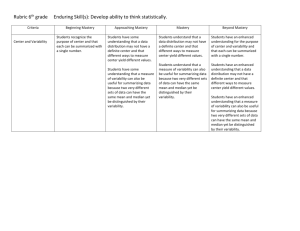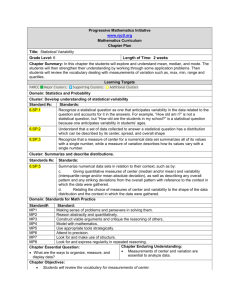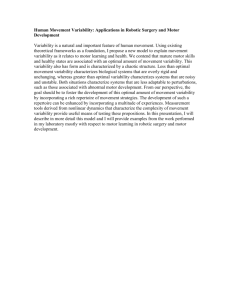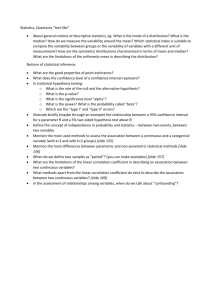methods
advertisement
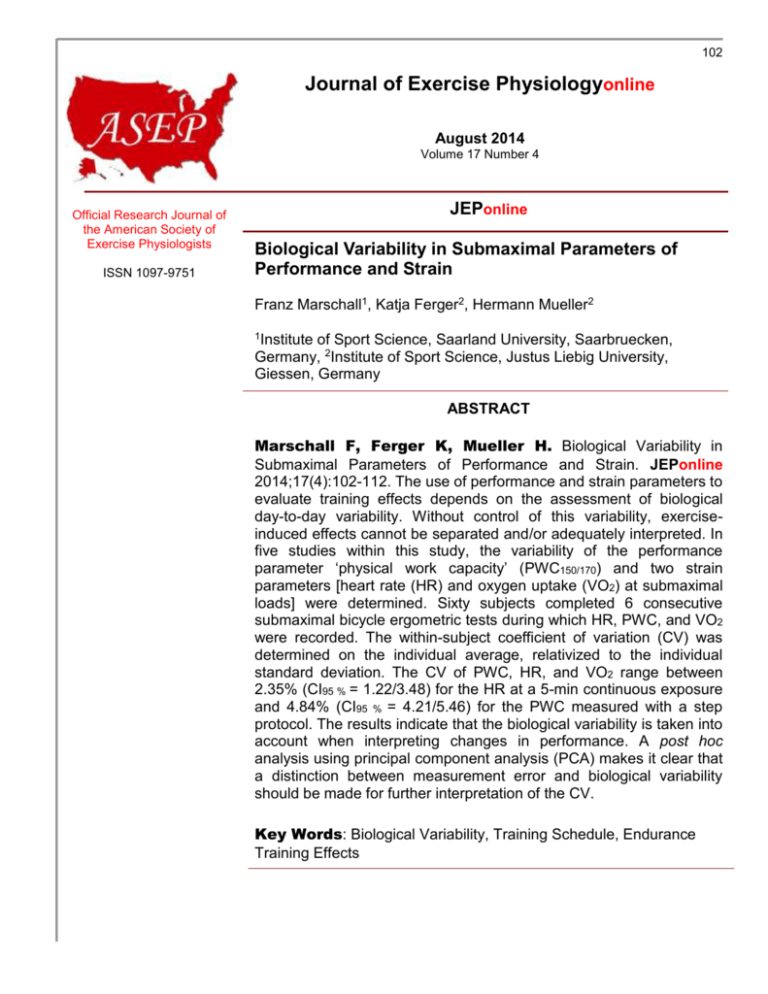
102 Journal of Exercise Physiologyonline August 2014 Volume 17 Number 4 Editor-in-Chief Official Research Journal of Tommy the American Boone, PhD, Society MBA of Review Board Exercise Physiologists Todd Astorino, PhD Julien Baker, ISSN 1097-9751 PhD Steve Brock, PhD Lance Dalleck, PhD Eric Goulet, PhD Robert Gotshall, PhD Alexander Hutchison, PhD M. Knight-Maloney, PhD Len Kravitz, PhD James Laskin, PhD Yit Aun Lim, PhD Lonnie Lowery, PhD Derek Marks, PhD Cristine Mermier, PhD Robert Robergs, PhD Chantal Vella, PhD Dale Wagner, PhD Frank Wyatt, PhD Ben Zhou, PhD Official Research Journal of the American Society of Exercise Physiologists ISSN 1097-9751 JEPonline Biological Variability in Submaximal Parameters of Performance and Strain Franz Marschall1, Katja Ferger2, Hermann Mueller2 1Institute of Sport Science, Saarland University, Saarbruecken, Germany, 2Institute of Sport Science, Justus Liebig University, Giessen, Germany ABSTRACT Marschall F, Ferger K, Mueller H. Biological Variability in Submaximal Parameters of Performance and Strain. JEPonline 2014;17(4):102-112. The use of performance and strain parameters to evaluate training effects depends on the assessment of biological day-to-day variability. Without control of this variability, exerciseinduced effects cannot be separated and/or adequately interpreted. In five studies within this study, the variability of the performance parameter ‘physical work capacity’ (PWC150/170) and two strain parameters [heart rate (HR) and oxygen uptake (VO2) at submaximal loads] were determined. Sixty subjects completed 6 consecutive submaximal bicycle ergometric tests during which HR, PWC, and VO2 were recorded. The within-subject coefficient of variation (CV) was determined on the individual average, relativized to the individual standard deviation. The CV of PWC, HR, and VO2 range between 2.35% (CI95 % = 1.22/3.48) for the HR at a 5-min continuous exposure and 4.84% (CI95 % = 4.21/5.46) for the PWC measured with a step protocol. The results indicate that the biological variability is taken into account when interpreting changes in performance. A post hoc analysis using principal component analysis (PCA) makes it clear that a distinction between measurement error and biological variability should be made for further interpretation of the CV. Key Words: Biological Variability, Training Schedule, Endurance Training Effects 103 INTRODUCTION Training effects in endurance training are evaluated either using performance parameters or strain parameters at a given performance level and recorded as the variation between pre- and post-test in the form of differential or percentage values. As a typical increase in performance at an intermediate to high starting level after several weeks of training, for example operationalized using the VO 2 max, 5 to 10% is determined (2,13) whereas at a low starting level (e.g., for seniors), increases of >20% can also be achieved (12). When interpreting these data it must be taken into account that besides exercise-induced effects, the changes in performance may be induced by the biological variability of the applied parameters (1). In this connection, as well as inter-individual variability, consideration should be given in particular to intra-individual variability. To obtain reliable inferences from the evaluation, the effects of training-induced changes in performance should significantly exceed biological variability (14). Related to this is the fundamental issue of the stability of the measurement(s) used (5). Based on regression and correlation analyses, Behrens et al. (4) established a biological variability for oxygen uptake (VO2) at maximum training load of 5% while an older study reported 5.6% and 11.2%, respectively (14). Submaximal measurements lend themselves to adequately determining the biological variability, particularly in recreational sports since in contrast to all-out tests (20) they respond more sensitively than maximal measurements to extensive endurance training (9). Bagger et al (1) studied 15 male runners and found a biological variability at submaximal loads of 3.3% for VO2 and 2.7% for heart rate (HR). Similar values can be found in numerous published papers (2,5,16,17,23). With the exception of the work by Becque et al. (3) and Lamberts and Lambert (16), all the other studies considered only 2 to 3 points of measurement, permitting the reliability to be determined, while the variability on the other hand only to a limited extent (14). In the present study, the biological variability of the performance parameter of submaximal physical work capacity (PWC) as well as VO2 and HR at submaximal loads was determined for various target groups with a sufficient number of points of measurement. PWC as the performance at a defined HR is in isolation neither suitable for performance diagnostics nor for inter-individual comparison and/or inferring training targets. However, it possibly responds more sensitively than the strain parameters HR and VO2 to intra-individual variation in endurance capacity especially after extensive endurance training (18,22). Furthermore, for the first time an approach is presented that allows a distinction to be made between measurement error-induced and biologically-induced variability for all three measurement values recorded. METHODS Subjects A total of 60 subjects (38 females; 22 males) participated in this study, which was in compliance with the ethical guidelines of the Declaration of Helsinki. Each subject signed an informed consent document before participation. Fifty-two full data sets were included in the evaluation. The purpose of this study was to identify the biological variability in various application-relevant settings. Three different measurements were considered in individual sub-studies. The submaximal performance parameter consisted of the PWC (24). Depending on the training level of the test subjects, which was determined using pulse rates of 150 and 170 beats·min-1 (21). In addition to this performance parameter, the two strain parameters of VO2 and HR at submaximal loads were determined. Heart rate, which was used to evaluate endurance capacity was partially recorded as a recovery HR at 104 defined time intervals after the submaximal load (5,16) or as a resting HR (17). It was used as the average heart rate at defined intervals of the submaximal endurance training load. Biological variability takes into account variations due to measurement error and intra-individual effects (10). In order to differentiate training-induced changes from such changes, variability as an interval-related measurement, as compared to reliability, can be considered adequate for the present analysis. However, more than 2 points of measurement (10) are necessary in a given period with unchanged training loads, thus permitting exercise-induced effects on the measurement values to be minimized (1,16,17). Taking into account the interaction of technically-related and biological measurement variation, values are calculated using different measurements (10,11). Due to the different scaling of PWC, HR, and VO2, as well as the large variation of the individual absolute values, the individual standard deviation was determined relativized to the individual average and calculated as the intra-individual coefficient of variation (CV) (6,11). In contrast to inter-individual variability, this method appears to be the most suitable for evaluating biological variability (i.e., taking into account more than three test times) (10). It was decided not to calculate the “critical difference” (1) due to the insufficiently clarified validity of the different methods (8,9). The biological variability determined using the CV is composed of measurement error-induced variability and “true” variability based on individual characteristics and conditions. In the studies, the “performance capacity” construct is operationalized and measured using three measurements. In those cases where PWC, HR, and VO2 are determined in parallel, principal component analysis (PCA) (7) offers the possibility to assess the proportion of the two variability components in the overall variability. To do this, data sets showing HR, VO2, and PWC determined in parallel at 6 measurement intervals were used. Based on these identified variance proportions, the variation relating to biological variability can then be separated from the variation caused by measurement error. It must, however, be noted that the relative effect of the principal components on overall variability tends to be overestimated, since the PCA does not take the dependency of the measurement errors into account in determining the parameters used. For this reason, the results are presented defensively with the addendum “approx.” All tests were performed on the Cyclus 2 bicycle ergometer (RBM, Leipzig). Heart rate was recorded using the Polar RS 800 heart rate monitor, and VO2 was determined with the Metalyzer 3B (Cortex, Leipzig). In a pre-test, the HR max and the maximal endurance capacity Pmax were determined on the basis of a standardized step protocol and the VO 2 peak (18) using a ramp test. For the submaximal tests the training loads were determined such that no training effects caused by the test repetition were to be expected. The submaximal tests were carried out at 6 consecutive points of measurement 24 to 48 hrs apart. During the 3-wk test phase, the test subjects were instructed to maintain their normal training load. All test subjects maintained a constant body weight during the test period in order to reduce circadian rhythm effects. Variability of the PWC To determine the biological variability of the PWC for untrained and moderately trained subjects, 20 sports students aged 20 to 27 (average age, 23.15 ± 2.62 yrs) were tested. Seven of the test subjects were male (average weight, 81.70 ± 12.14 kg) and 13 were female (average weight, 59.08 ± 5.17 kg). To determine the biological variability of the PWC for an endurance-trained subject, 5 racing cyclists from the U23 and the elite amateur class (average age: 21.2 ± 2.8 yrs, average weight: 70.4 ± 10 kg) were tested. The tests were carried out during the transitional period. The training sessions performed by the test subjects during this time were completed at high volume and with low intensity. Only one test subject was preparing for a competition during the test period. 105 In two separate case studies, the variability of the PWC was additionally determined over a period in which the tests themselves can be expected to produce a training effect and/or additional training loads are likely to increase the variability. The test subjects were an untrained male aged 27 yrs, 2.04 m, and 93 kg and a trained male aged 25 yrs, 1.94 m, and 81 kg. The test phase for the two separate case studies extended over 21 consecutive days during which the PWC150 of both test subjects was calculated daily. Variability of the HR To determine the biological variability of the HR, 10 sports students (average age 23.7 ± 2.87 yrs) 8 of whom were female (62 ± 7.23 kg) and 2 male (78 ± 5.66 kg) were tested over a period of 8 wks. The individual HR was recorded for a 5-min continuous exposure (with 3 min retraction and 4 min extension) at constant submaximal loads. Variability of the VO2 The biological variability of the VO2 was determined over a period of 12 days. The test subjects were 17 female and 6 male sports students. At the time of the test, the age of the men was 26.3 ± 3.1 yrs and the age of the female was 24.1 ± 3.4 yrs with a mean height of 171.67 ± 12.43 cm (men: 185 ± 9.54 cm; women: 165 ± 7.13 cm), and a mean weight of 66.11 ± 13.68 kg (men: 80.27 ± 3 kg; women: 59.03 ± 10.74 kg). RESULTS The coefficients of variation range between 2.35% (CI 95=1.22/3.48) for the HR at a 5-min continuous exposure with 70% of the Pmax and 4.84% (CI95=4.21/5.46) and 3.77% for the PWC measured with a step protocol, as well as 3.61% for the VO2, similarly measured with a step protocol. Table 1 presents a first overview of the overall results of all studies. Table 1. Overview of the Results. Study N Parameter Points of Measurement CV 1 20 PWC150/170 6 4.84% ± 1.34 2 10 HF 6 2.35% ± 1.57 3 24 VO2 6 3.23% ± 0.99 4 2 PWC150 21 10.6% (untrained) 9.5% (trained) Figure 1 shows the Coefficient of Variation of the HR for the individual test subjects at a 5-min continuous exposure with 70% Pmax, as well as the results relating to the biological variability of the PWC. For male and female subjects alike, the CV is independent of the target HR (170 or 150) of the PWC. For trained racing cyclists, the variability of the PWC is slightly lower. 106 Figure 1. Coefficients of Variation of the HR (AV = 2.35%, ± 1.57) of the PWC of Racing Cyclists (3.77%; ± 0.11) and Sports Students (4.84%; ± 1.34). To determine the individual performance variation, the Coefficient of Variation for all six submaximal stress tests was calculated for each test subject (Figure 2). Here, too, the results show that the variability of physiological processes does not depend on the level of performance or the HR. Furthermore, this study again produced no gender-specific differences. Figure 2. Coefficients of Variation of the VO2 for the Individual Test Subjects (AV = 3.61%; ± 1.53). 107 In sum, the results show an average biological variability of 2.35% for the HR, 4.84% for the PWC for sports students, and 3.77% for the racing cyclists, as well as 3.61% for the VO 2, and are thus similar to the results obtained in comparable studies (1). The recorded values are independent of the intensity of the training load and the HR max. The variability can be considered as gender-unspecific. Results of the Separate Case Studies This study looked at the variability of the PWC over 21 consecutive days for two test subjects (trained / untrained). A first look at the values shows a coefficient of variation of 10.6% for the endurancetrained person, and of 9.5% for the untrained test subject. Both values are thus significantly higher than the values in the group studies. If for the endurance-trained subjects we ignore the four points of measurement ahead of which a 90-min aerobic-anaerobic endurance exercise took place (league football match), the coefficient of variation drops from 10.6% to 2.1%. Figure 3. PWC150 Values, Trained Subject. The post hoc analysis using the PCA identifies shared proportions of variance for the three PWC, HR, and VO2 measurements recorded. For biological variability this proportion is ~70%, for measurement error-induced variability ~30% (Figure 4a). Differentiated according to the parameters however, the proportion of biological and measurement error-induced variability relative to the CV presents itself differently (Figure 4b). The CV of the parameter of PWC150/170 can be broken down to a ratio of 5:1, which for the biological variability corresponds to a proportion of ~83%. The CV of the parameter HR is distributed more or less equally between the two components, while the CV of the parameter VO 2 shows a lower proportion of biological variability (~40%) and a higher proportion of measurement error (~60%). 108 Figure 4. Principal Components of the Explained Variance for PWC150/170, HR, and VO2 (a) as well as the Ratio of True (Biological) and Measurement Error-Induced Variance (b). DISCUSSION The results of the tests clearly show that both the performance and the strain parameters are subject to biologically-induced variability that should be taken into account when evaluating short- and longterm training effects. The recorded values for the variability are comparable to those established in previous studies (1,16). Somewhat surprisingly, the variability of the HR at a 5-min continuous exposure, whose intensity was determined with 70% of the maximal endurance capacity measured with a step test, is lowest with a mean CV of 2.35% and a confidence interval KI95% of 1.22 to 3.48%. The PWC recorded with a step test varies considerably more noticeably, both for moderately endurance-trained test persons with an average of 4.84% (KI95% = 4.21 to 5.46%) and for racing cyclists with an average of 3.77%. These differences can be explained by the fact that the calculation of the PWC (for the formula cf. (19)) is based on HRs at different performance levels and even slight deviations when determining the HR reached before the target HR can lead to high displacements of the ratio contained in the formula. The mean HR during the 5-min continuous exposure does not lead to different values, irrespective of whether averaged during the last 2 min, the last minute or the last 30 sec. The variation for VO2 lies almost exactly mid-way between that determined for HR and PWC. In light of the high equipment requirement for measuring VO 2 and the higher margin of interpretation in determining the precise value, especially for inexperienced testers, this method seems less suitable for evaluating training effects (18). What consequences do the available findings have for controlling and evaluating effects within the scope of training studies? Many test manuals consider familiarization to be a central aspect when it comes to determining an initial or reference value. Kraemer and Fry (15) postulate a period of 2 wks or 4 training sessions for this. Only then in their view is it possible to largely reduce systematic learning- or training-induced measurement errors. While these statements relate to strength training, 109 in principle the same arguments apply for endurance tests on the treadmill or bicycle for a familiarization phase prior to the test, the results of which can additionally be used to estimate the variability. The submaximal methods applied in the present study permit such a procedure and would therefore be suitable to validly determine the initial performance prior to training intervention. In the present study the CV as a within-subject coefficient of variation was determined on the individual average, relativized to the individual standard deviation. As opposed to calculating an overall variation, in our view this method better reflects the relevance of this study, which due to its explorative character was based on relatively small test samples. Calculating an overall variation would be appropriate for method comparison or determining standard values for specific target groups. Compared to the standard measurement error, the advantage of the CV is that measurement value differences resulting in particular from the large variation in individual HRs do not influence the CV. Calculating a critical difference (1) is arithmetically identical to a confidence interval and does not contain more differentiated information than the CV and has, therefore, not been taken into account for the present research. Special consideration is given to the two additional separate case studies within this study. It appears that the variability is lower for trained than for untrained subjects. If we disregard the PWC value of the test subject in study 4, who during the test period was in training for a competition, the CV is 3.77% with a standard deviation of 0.11%. This provides grounds to systematically replicate the findings, which were based on a total of only 5 test subjects altogether, with a larger test sample. Another important finding results from the large deviations in the performance of trained subjects after more intensive training loads. The PWC as a representative of performance is apparently also sensitive to short-term changes in endurance-trained subjects without the daily recording showing a training effect. The difference between the CV taking into account the measurements immediately following intensive training loads (CV21 = 10.6%) and the CV without taking these into account (CV 17 = 2.1%) from the separate case study confirms the postulation of Lamberts et al. (17) that only training periods with unchanged training loads are suitable for determining biological variability. Moreover, the results of the separate case studies suggest that effects in training studies over a longer period with uncontrolled variability have to be considered critically and, therefore, need to be relativized. CONCLUSIONS All in all the results indicate that in training studies and when monitoring the training process the biological variability of the respective measurement parameters should be taken into account when interpreting training effects. Without these control data it is not possible to separate exercise-induced effects and biologically-induced changes (1). It seems appropriate to replicate and substantiate the present findings with larger test samples in each case, and thus create a database for standard values. This applies equally to the detailed analysis using the PCA. This method makes it possible to differentiate the global CV according to different ratios. The parameters used differ significantly in terms of the degree of influence of measurement error-induced and biologically-induced variability. Depending on the aim when evaluating training effects, the result of the PCA could be drawn on to select the most suitable parameter. If the aim is to minimize the effect of biological variability on exercise-induced changes, according to the results of the present studies VO 2 would be the most suitable. However, it should be noted that the overall variability for VO 2 is greatest and the method of measurement is also the most complex, as shown by the high measurement error-induced proportion of variance. The PWC constitutes an indicator for which measurement errors only marginally affect 110 the variability, but which allows personal factors to be more clearly identified. Since the PWC can also be determined relatively simply and without all-out tests, it would appear to be especially suited for endurance-oriented training studies at lower to intermediate levels. The post hoc and explorative PCA used in the present study appears suitable for differentiating the CV and should be used assuming the conditions are met. Acknowledgment We thank Janet S. Wheeler, MA, (Saarland University) for her helpful support in translating the manuscript into the English version. Address for correspondence: Franz Marschall, PhD, Institute of Sport Science, Saarland University, Saarbruecken, Germany, Email: f.marschall@mx.uni-saarland.de REFERENCES 1. Bagger M, Petersen PH, Pedersen PK. Biological variation in variables associated with exercise training. Int J Sports Med. 2003;24(6):433-440. 2. Baquet GE, Van Praagh E, Berthoin S. Endurance training and aerobic fitness in young people. Sports Med. 2003;33(15):1127-1143. 3. Becque MD, Katch V, Marks C, Dyer R. Reliability and within subject variability of VE, VO 2, heart rate and blood pressure during submaximum cycle ergometry. Int J Sports Med. 1993;14(4):220-223. 4. Behrens S, Andresen D, Brüggemann T, Ehlers C, Schröder R. Reproduzierbarkeit der symptomlimitierten Sauerstoffaufnahme und der anaeroben Schwelle im Rahmen spiroergometrischer Untersuchungen bei Patienten mit Herzinsuffizienz. [Reproducibility of symptom-limited oxygen uptake and anaerobic threshold under spiroergometric studies in patients with heart failure]. Zeitschrift für Kardiologie. 1994;83(1):44-49. 5. Borresen J, Lambert MI. Changes in heart rate recovery in response to acute changes in training load. Eur J Appl Physiol. 2007;101(4):503-511. 6. Bortz J. Statistik für Sozialwissenschaftler. [Statistics for Social Scientists]. (5th Edition). Berlin: Springer, 1999. 7. Daffertshofer A, Lamoth CJ, Meijer OG, Beek PJ. PCA in studying coordination and variability: a tutorial. Clin Biomech. 2004;19(4):415-428. 8. Fraser CG, Hyltoft Peterson P, Larsen ML. Setting analytical goals for random analytical error in specific clinical monitoring situations. Clin Chem. 1990;36(9):1625-1628. 9. Harris EK, Yasaka T. On the calculation of a "reference change" for comparing two consecutive measurements. Clin Chem. 1983;29(1):25-30. 111 10. Hopkins WG, Schabort EJ, Hawley JA. Reliability of power in physical performance tests. Sports Med. 2001;31(3):211-234. 11. Hopkins WG. Measures of reliability in sports medicine and science. Sports Med. 2000;30 (1):1-15. 12. Huang G, Gibson CA, Tran ZV, Osness WH. Controlled endurance exercise training and VO2max changes in older adults: A meta-analysis. Prev Cardiol. 2005;8(4):217-225. 13. Jones AM, Carter H. The effect of endurance training on parameters of aerobic fitness. Sports Med. 2000;29(6):373-386. 14. Katch VL, Sady SS, Freedson P. Biological variability in maximum aerobic power. Med Sci Sports Exerc. 1982;14(1):21-25. 15. Kraemer WJ, Fry A. Strength testing: Development and evaluation of methodology. In Maud PJ, Foster C. (Editors). Physiological Assessment of Human Fitness. Champaign, IL: Human Kinetics. 1995, p. 115-138. 16. Lamberts RP, Lambert MI. Day-to-day variation in heart rate at different levels of submaximal exertion: Implications for monitoring training. J Strength Cond Res. 2009;23(3):1005-1010. 17. Lamberts RP, Lemmink KAPM, Durandt JJ, Lambert MI. Variation in heart rate during submaximal exercise: Implications for monitoring training. J Strength Cond Res. 2004;18 (3):641-645. 18. Meyer T. Belastungsuntersuchungen. Praktische Durchführung und Interpretation. [Exercise testing. Practical application and interpretation] In Kindermann W. (Editor). Sportkardiologie. Körperliche Aktivität bei Herzerkrankungen. [Sports Cardiology. Physical Activity in Heart Disease]. Darmstadt: Steinkopf. 2007, p. 39-66. 19. Neumann G, Schüler KP. Sportmedizinische Funktionsdiagnostik. [Sports Medical Functional Diagnostics]. (2nd Edition). Leipzig, Berlin, Heidelberg: Barth, 1994. 20. Pfeiffer M, Perl J. Simulative Trainingswirkungsanalyse bei einem Fahrradergometer-training mittels antagonistischer Modelle. [Simulative Training impact analysis on a bicycle ergometertraining with antagonistic models]. In Lames M, (Editor). Gegenstand und Anwendungsfelder der Sportinformatik. [Object and Applications of Computer Science in Sport]. Symposium of dvs-Sektion Sportinformatik from 22 - 24 May 2008 Augsburg (Germany). Hamburg: Czwalina. 2009, p. 41-51. 21. Rowland TW, Rambusch JM, Staab JS, Unnithan VB, Siconolfi SF. Accuracy of physical working capacity (PWC170) in estimating aerobic fitness in children. J Sports Med Phys Fitness. 1993;33(2):184-188. 22. Scharhag-Rosenberger F, Meyer T. Ausdauertrainingseffekte: Ergometrische Erfassung und Zusammenhänge mit präventiver Trainingswirkung. [Endurance training effects: Ergometric detection and contexts with preventive training effect]. Deutsche Zeitschrift für Sportmedizin. 2013;64(2):45-51. 112 23. Stanforth PR, Gagnon J, Rice T, Bouchard C, Leon AS, Rao DC, Skinner JS, Wilmore JH. Reproducibility of resting blood pressure and heart rate measurements. The HERITAGE Family Study. Ann Epidemiol. 2000;10(5):271-277. 24. Wahlund H. Determination of the physical working capacity: A physiological and clinical study with special reference to standardization of cardio-pulmonary functional tests. Acta Medica Scandinavica. 1948;132:(Suppl. 215). Disclaimer The opinions expressed in JEPonline are those of the authors and are not attributable to JEPonline, the editorial staff or the ASEP organization.




